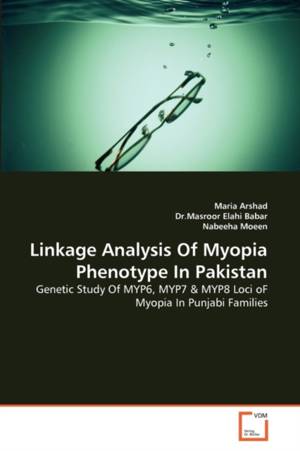
- Afhalen na 1 uur in een winkel met voorraad
- Gratis thuislevering in België vanaf € 30
- Ruim aanbod met 7 miljoen producten
- Afhalen na 1 uur in een winkel met voorraad
- Gratis thuislevering in België vanaf € 30
- Ruim aanbod met 7 miljoen producten
Zoeken
Linkage Analysis Of Myopia Phenotype In Pakistan
Maria Arshad, Masroor Elahi Babar, Nabeeha Moeen
Paperback | Engels
€ 72,45
+ 144 punten
Omschrijving
Myopia is a refractive abnormality of the eye in which the parallel light rays from an object at optical infinity are focused by the eye in front of the retina rather than on it. This is the first experimental study on Myopia in Pakistan because this disease is spreading here day by day with prevalence rate of 36.5%. Microsatellite markers have been proved as an efficient and powerful tool for discovering any diseased locus. So a panel of these markers was used in this study. Blood samples of various myopic families were collected from various areas of Punjab and their DNA was extracted with the standard protocol. The amplification of DNA was done with primers of microsatellite markers belonging to the loci MYP6, MYP7 and MYP8. Genotyping was done for linkage analysis through PAGE. Haplotypes were made and the results showed potential linkage against MYP7 locus in one of the five familes with autosomal dominant mode of inheritance. Later the LOD Score for this family was calculated and maximum LOD score came out to be 0.0803 at the marker D11S904 that showed very low percentage of linkage. This can be confirmed by extending the family by further sampling.
Specificaties
Betrokkenen
- Auteur(s):
- Uitgeverij:
Inhoud
- Aantal bladzijden:
- 108
- Taal:
- Engels
Eigenschappen
- Productcode (EAN):
- 9783639354041
- Verschijningsdatum:
- 6/05/2011
- Uitvoering:
- Paperback
- Afmetingen:
- 152 mm x 229 mm
- Gewicht:
- 168 g

Alleen bij Standaard Boekhandel
+ 144 punten op je klantenkaart van Standaard Boekhandel
Beoordelingen
We publiceren alleen reviews die voldoen aan de voorwaarden voor reviews. Bekijk onze voorwaarden voor reviews.








